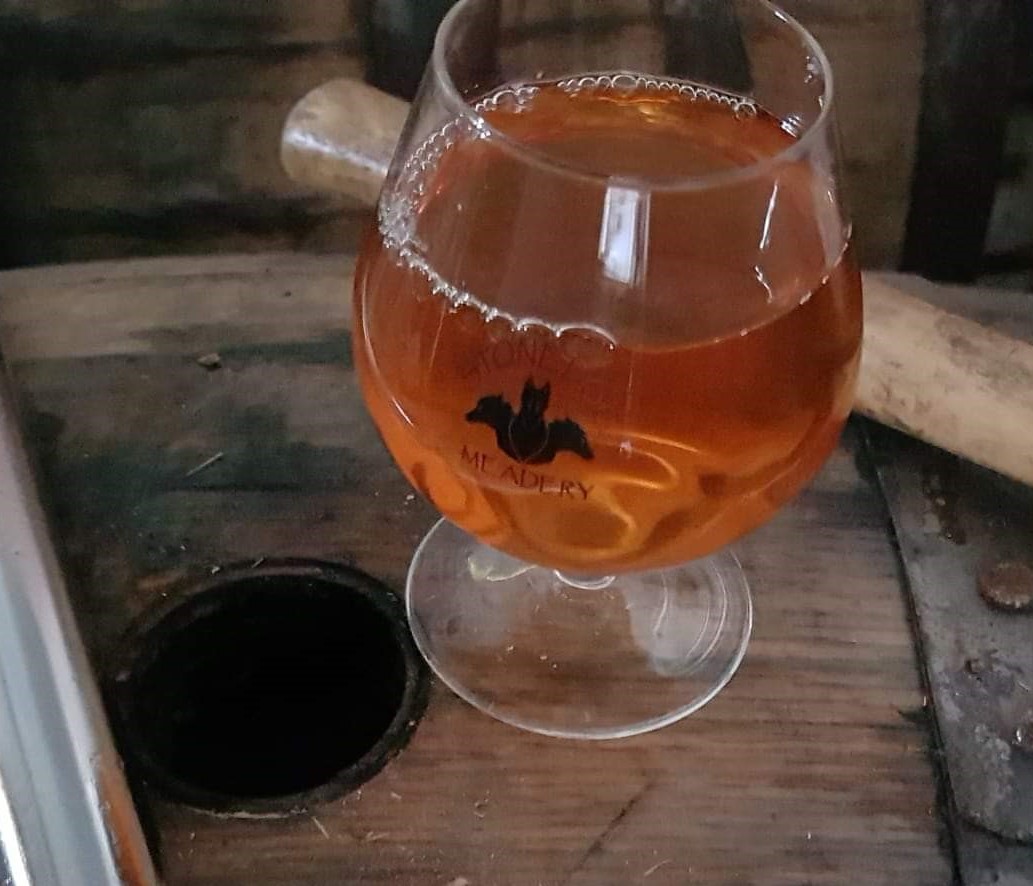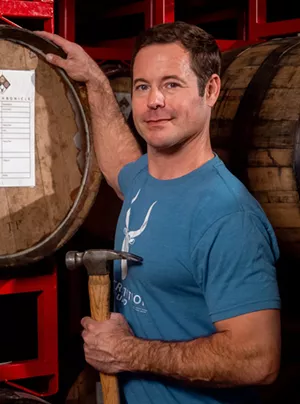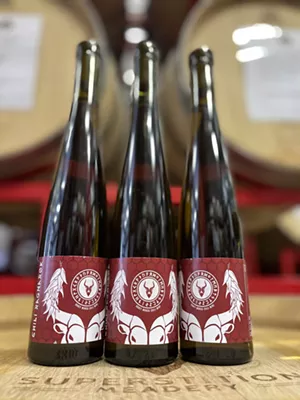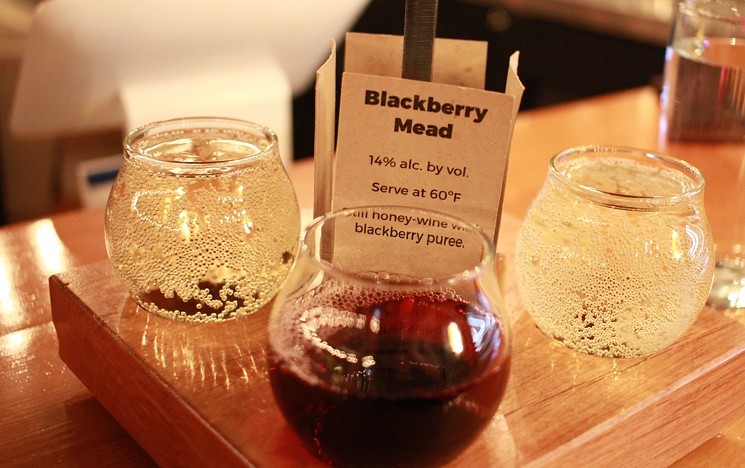From hospitalitymagazine.com.au
The inception of Stone Dog Meadery is one for the romance books. Founders Steve and Lavender Kirby met online in 1998, penning emails to each other before Lavender — an avid medieval fair fan — made the move to Australia.
Steve (who has been involved in brewing personally and professionally since the age of 17), was more than up for the challenge when Lavender suggested he try his hand at mead. The rest as they say is history.
Australia’s mead circuit is small, but mighty — and growing. When Stone Dog started out, Steve estimates there were five businesses producing mead, only one of which was a dedicated meadery. Fast-forward eight years and the local footprint has now grown to around 30 players.
After producing more than 20,000 bottles of mead, it’s safe to say honey wine is on the up and Stone Dog is onto a good thing. Hospitality speaks to Stone Dog Co-Founder Steve about the nuances of the brewing process, working with different honeys and letting nature do its thing.
Mead is one of the earliest forms of alcohol, having been consumed by people all over the world for millennia. Generally known as honey wine, mead comprises just a handful of ingredients: honey, water and yeast, which are combined and left to undergo a fermentation process. Basically, it’s wine made from honey, not grapes.
Steve Kirby tells the following story when asked to describe mead: “A bushman somewhere came across a tree stump filled with liquid, drank it, woke up two days later and said, ‘Jeez that was good, I’ll go and find another one’,” he says. “Beehives occur in tree hollows, and when a lightning strike destroys the hollow, the bees
move on and leave the honey behind. With a little bit of rain, the honey will ferment naturally. It’s the only alcoholic beverage that can occur without intervention.”
Kirby lives on a bush-block property in Tarago in the Southern Tablelands of New South Wales. He and wife Lavender run chickens and pigs on their farm, which is also home to a 20-foot refrigerated shipping container — the nucleus of Stone Dog’s operations. “Mead was virtually unknown in Australia in 2014,” says Kirby.
“I had a go at it and our caramelised orange blossom [Odin’s Reserve] took out gold at the Australian National Home Brewing Conference that year. From there, we spent the next five years building the market and educating people about what mead was. I travelled around Australia talking to home brew groups and going to conferences to try and get the word out.”
Stone Dog’s range is varied, but traditional. But most importantly, each brew is a sum of its parts. Kirby sources honey from keepers across the country, which means the meads have a unique flavour profile. “A lot of our time is spent sourcing good honey; we work with people who do pollination services, and they know exactly where the hives are.”
An example is scotch thistle honey, which is the result of an untended infestation. “It isn’t a regular honey; you can only get it from places where the thistles haven’t been dealt with by the farmer,” says Kirby. Stone Dog sources macadamia honey from
north-eastern New South Wales and south-eastern Queensland and red gum honey from Wagga. “Semi-regional areas provide a unique flavour.”
While the type of honey may vary, the brewing process does not, and neither do the other key ingredients. Stone Dog uses Lalvin ICV D47 yeast, which is commonly used to make wines such as Chardonnay and Rosé.
“It’s a bit strange to use a nice wine yeast for mead, but it gives the balance of esters and flavours while retaining the honey’s profile,” says Kirby. Nutrients are also added, which is critical when it comes to productivity. “Honeys are 99 per cent sugar; they don’t have the nutrients that yeast has to propagate properly,” says Kirby.
“When we started, it was common for mead to take six months to a year to ferment out at 11–15 per cent. But research and processes such as TOSNA [nutrient regime], which is all about staggered nutrient additions, gives the yeast what it needs to propagate. Now, 13–15 per cent meads are produced in about eight to 10 weeks.”

Stone Dog also experiments with aromat additions such as chipotle chillis, pepper and cacao nibs. “I love star anise; we haven’t used it commercially yet, but we are developing it,” says Kirby. “The ingredients make something together that’s more than what you started with, if you get what I mean.”
Stone Dog brews mead in stainless-steel variable capacity tanks in the “fermentation house” — aka the shipping container. “We’ve had it since the start and it allows us to control the temperature and operate in a nice, clean area,” says Kirby.
The mead, which is made in 120–130L batches, is mostly left to its own devices during the brewing process, besides the occasional degas. “The process is pretty much the same across all of the meads and we take a hands-off approach,” says Kirby. “But when fermentation happens, a lot of carbon dioxide builds up in the brew itself and it can change the acidity if you don’t stir it up.”
To gauge a mead’s readiness, Kirby looks for stability, taste, sweetness and clarity. “We gauge stability by using hydrometers to measure the specific gravity,” he says. “We want the alcohol to be stable for at least a week and for the sediment to start to drop out.”
The end ABV all comes down to the product itself — there’s no parameters. “The traditional meads sit between 10–18 per cent,” says Kirby. “Because we are small batch, we can let the honey and yeast work to where it wants to go rather than driving it to reach a certain point because we’ve printed 10,000 labels. Our batches all have their own unique flavours, and while the base will be the same, the alcohol percentages and residual sugars are different.”
A reflection of the practice is a sweet mead made with scotch thistle honey. “It got to 6.7 per cent and it just didn’t want to go any further,” says Kirby. “We gave it a lot of time and more yeast, but it said, ‘No, this is where I want to stop’. So we bottled it and it was a dessert wine with a unique scotch thistle flavour. Part of our core beliefs or thinking is what we produce should taste like what we are using — we want to showcase the honey.”
Once the brewing process is wrapped up, Stone Dog uses a single-head vacuum filler to bottle the mead. “We’re still on the first unit we bought,” says Kirby, who also built a three-head pressure filler for session meads.
So, what is the best way to enjoy mead? The answer is far-reaching. It can be chilled with ice and served tall, warmed up for a soothing sipper or reduced to make a syrup to drench cakes.
“Everyone used to know mead as something that was super sweet that you only drank in winter,” says Kirby. “Our macadamia dry called Heading to the Desert is tasting like a baked Chardonnay and we are currently serving it warm to people at the market.”
The brewer also suggests spicing mead with a bespoke combination of aromats, topping it with soda or tonic water or enjoying it in the same way you would drink a cider or a beer.
“A session mead easily fits into the category,” says Kirby. “It’s so versatile these days — it’s not just a one-dimensional drink.” While the growth of meaderies in Australia is slow, there’s no doubt progress is being made. “There are still meaderies popping
up, but not at the same rate as before COVID,” says Kirby. “I know a few that haven’t survived, but there are more in planning.”
The brewer compares mead’s possible trajectory in the liquor sector to that of the global craft beer movement, which was once shiny and new. “We tend to say we are five years behind the craft beer industry — we follow on their coattails,” says Kirby. “The US has around 450 meaderies operating. They are also all through Europe, popping up in South Africa and there are a few originals in South America.”
The launch of the Mead Australia organisation will also go a long way to ensuring and supporting the future success of honey wine in Australia. “Mead has changed so much here just in the time we have been operating,” says Kirby. “We have helped change the game.”
https://www.hospitalitymagazine.com.au/australias-mead-industry-is-just-getting-started/









